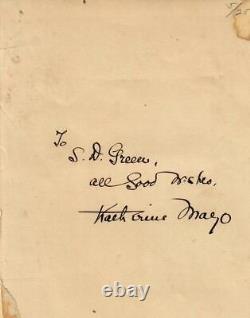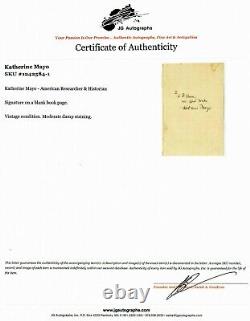
- Homepage
- Autographed
- Industry
- Movie
- Avengers (2)
- Avengers Endgame (4)
- Deadpool 2 (4)
- Flashdance (3)
- Frozen (2)
- Men In Black (3)
- Movie (14)
- Pulp Fiction (3)
- Rosemary's Baby (4)
- Scarface (4)
- Spider-man (2)
- Star Wars (18)
- Suicide Squad (4)
- Tarzan (5)
- The Devil's Advocate (3)
- The Lost Boys (5)
- The Revenant (6)
- Venom (3)
- Vikings (2)
- Viva Las Vegas (2)
- Other (4193)
- Object Type
- Signed
- Signed By
- A Star (12)
- Al Pacino (7)
- Artist Ms (11)
- Barack Obama (5)
- Betty White (5)
- Billy Wirth (5)
- Carrie Fisher (20)
- Dalai Lama (5)
- Donald Trump (30)
- Hong Eunchae (5)
- Jimmy Carter (5)
- Mike Trout (8)
- Roman Polanski (5)
- Ryan Reynolds (4)
- Shohei Ohtani (9)
- Stan Lee (7)
- Stephen Curry (5)
- Taylor Swift (5)
- Tom Brady (5)
- Tom Hardy (6)
- Other (4122)
RARE Mother India Katherine Mayo Hand Signed Page JG Autographs COA




"Mother India" Katherine Mayo Hand Signed Page. This item is certified authentic by JG Autographs and comes with their Letter of Authenticity. (January 27, 1867 - October 9, 1940) was an American historian and nativist. Mayo entered the public sphere as a political writer advocating.
Immigration to the United States, along with promoting racist stereotypes of African Americans. She became known for denouncing the. And religious grounds, and then went on to publish and promote her best-known work. (1927), a deeply critical book on Indian society, religion and culture. Written in opposition to the.
The book received a sharply divided reception upon its publication and was accused by several authors of being Indophobic, including. To James Henry and Harriet Elizabeth (Ingraham) Mayo, and was educated privately. Shortly after graduation, she started work as a researcher and historian by helping. (whose father owned the newspaper) prepare his book.
Which was published in 1910. Villard was a founder of the. And an officer of the. National Association for the Advancement of Colored People. He influenced Mayo to become active in several social reformist circles. Mayo also became a member of the. And maintained links with the. Daughters of the American Revolution. Which at the time largely shared her hostility towards non-white and Catholic. Several of Mayo's early writings promoted anti-Catholicism and racist views towards people of color. Mayo combined anti-Catholicism and anti-Filipino sentiment in her writings that opposed the. Mayo's early journalistic works promoted an. Version of American nationalism and contained xenophobic remarks towards Irish immigrants, as well as racist views of African Americans. Mayo claimed that "negroes" were sexually aggressive and lacked self-control, thus rendering them a threat to "innocent white Anglo-Saxon women". Mayo put her writing skills behind the effort to establish the. And supported their efforts to suppress immigrants and African Americans whose involvement in labor rights movements were viewed by Mayo as a threat to.
